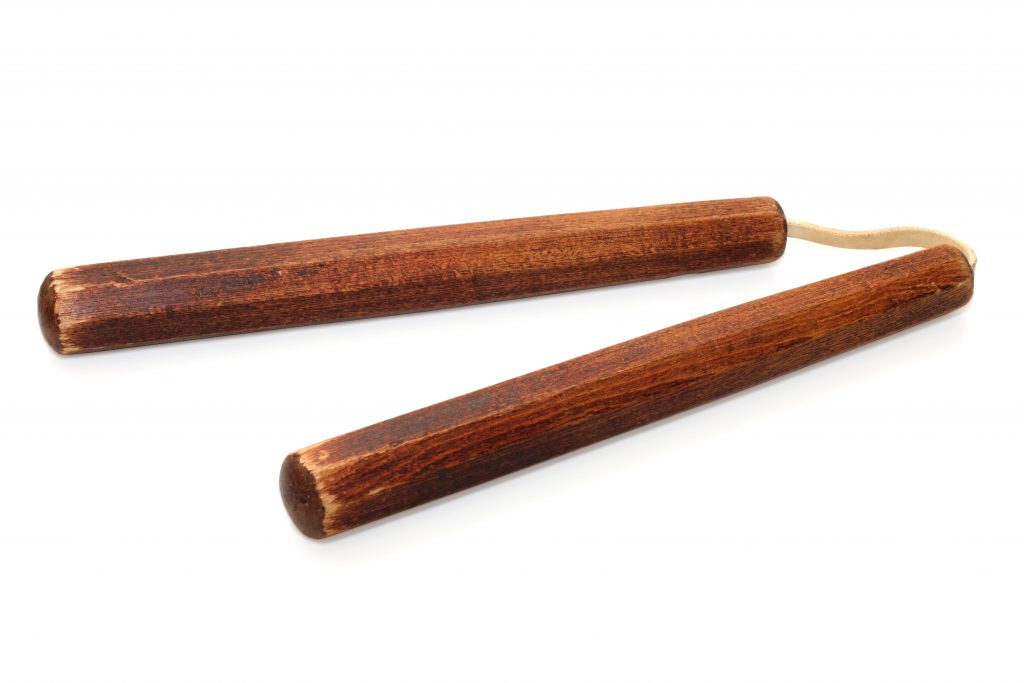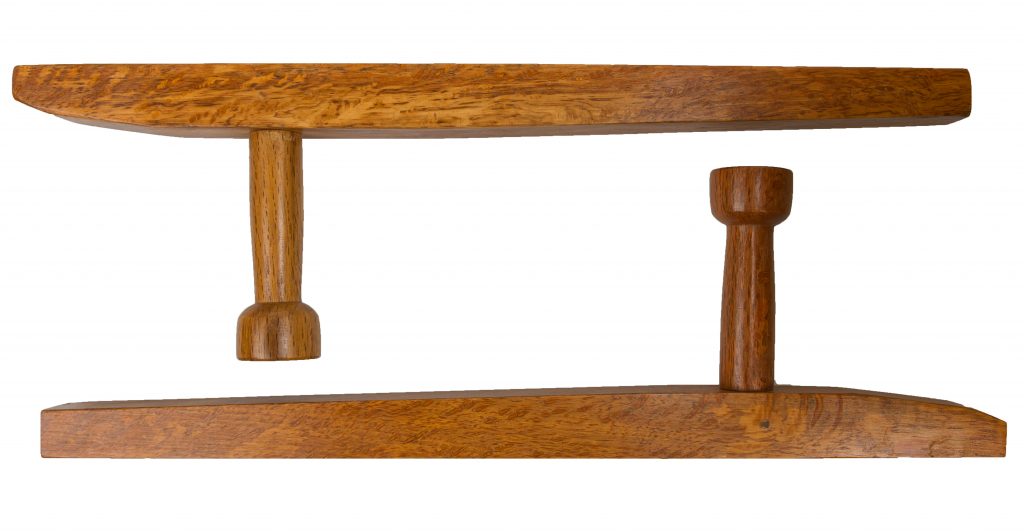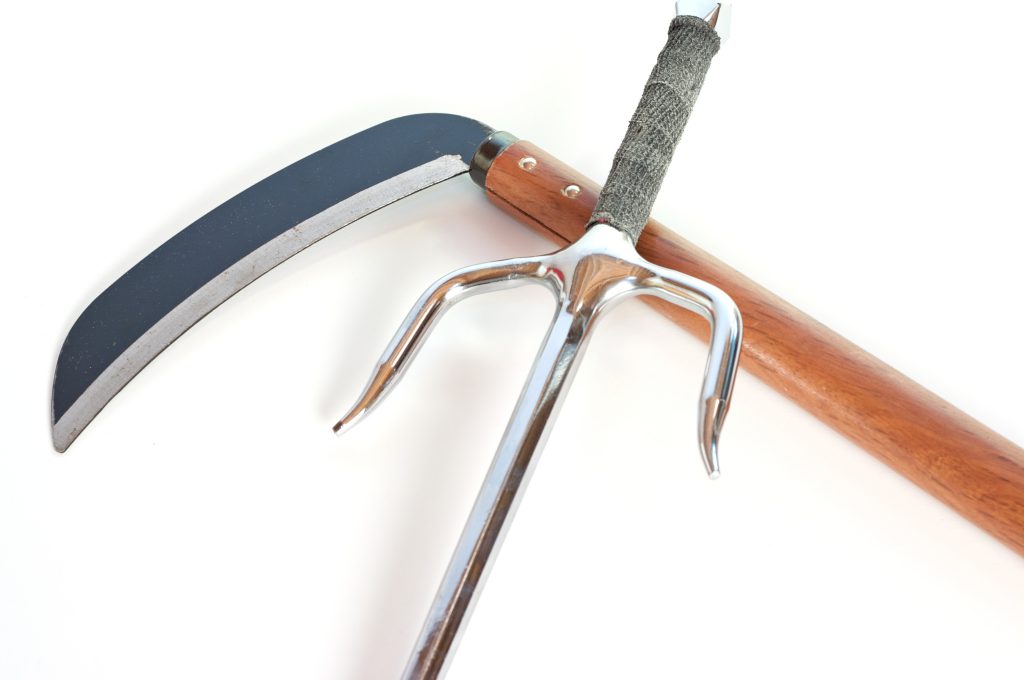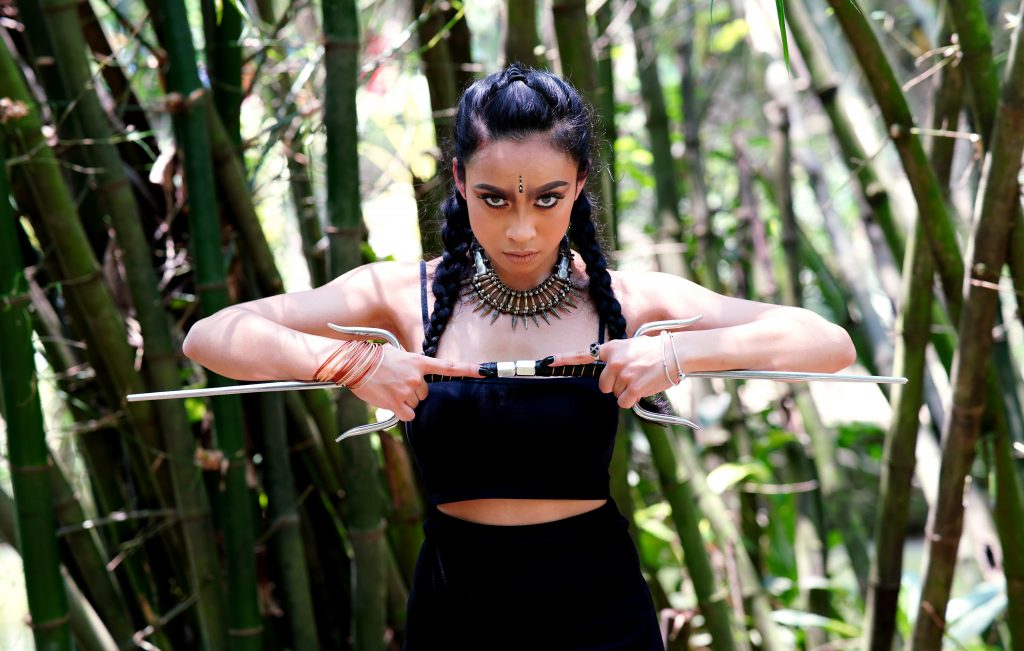What!? Karate weapons? That doesn’t sound right!
If you’ve read our recent post on what Karate means you know that the literal translation of Karate in Japanese is “empty hand.” The logical implication here is that there are no weapons used in Karate.
Strictly speaking, this is true. There are no real “Karate weapons”. However, there is a list of Karate weapons that many Karateka train with. Let’s dive in and learn all about them!
Table of Contents
The History of Karate Weapons
So, if fighting weapons don’t exist in Karate, where did these weapons come from and why are they associated with Karate?
It’s all because of the Okinawans.
Karate, though based on an ancient form of Chinese martial arts, didn’t become a Japanese martial art or get its name until 1936. It was developed on the island of Okinawa and its name changed to distance it from the Chinese (Japan’s enemy) when it was brought to Japan by Funakoshi Gichin, the father of modern Karate.
Also on Okinawa, the story goes that the commoners and farmers were prohibited from having weapons or practicing martial arts when the area was invaded by the Samurai from the Satsuma clan. Thus, they hid their training and fashioned crude weapons from farm tools.
Training with these Okinawan weapons came to be known as Kobudo. If you want to get technical, most Karate weapons are actually Kobudo weapons.
Most Okinawan martial artists trained in both arts and many Karate moves can be performed with a weapon in hand for greater effectiveness. Thus, there is a lot of crossover between the two and it’s only natural that Karateka would pick up these weapons as part of their training.
Traditional Japanese weapons also found their way into the mix, so quite an arsenal of “Karate weapons” has developed over the years.
In the modern-day, of course, you’ll see flashy Asian weaponry like tonfa, nunchaku, and ninja throwing stars in TV and movies, making them synonymous in popular culture with Karate.
A Complete List of Karate Weapons (Kobudo Weapons)
Now that we understand where the “Karate weapons” come from, let’s learn about them. Many of these deadly weapons have a fascinating history.
1. Bo
The Bo is a staff about 5 or 6 feet (152 to 182 cm) long that the Okinawans often carried around and was, surprisingly, not considered a weapon. The origin of this versatile weapon is unclear.
It may have been simply developed from walking sticks or it may have evolved from the tenbin, a long stick used across the shoulders for carrying buckets of water, baskets, or sacks. Another theory is that it was adapted from the handles of tools such as a shovel or rake.
Regardless of how it was developed, it is a formidable weapon. The wooden staff is heavy, usually made of oak. For greater speed and agility to perform fancy twirls and techniques, sometimes the ends are tapered to reduce the weight. This style is popular in Karate tournaments as it allows the practitioner to get a little more flashy with their techniques.
In training, a non-tapered heavier staff is typically used. This helps the student build strength as well as the heavier staff better absorbs the impact from blows.
The Bo allows for strong, long-range attacks, as well as provides excellent defense for the user. It can also be used to sweep the opponent’s legs and bring them to the ground.
https://www.youtube.com/watch?v=ywfo7ZBOcJ0
2. Hanbo
The Hanbo is like the Bo’s scrappy kid brother. Like the Bo, it is a simple wooden staff that can do some serious damage when wielded by an expert. However, this staff is shorter, typically only about 3 feet long (91 cm), or customized to match the length between the hip and ankle.
Though many of the same techniques as the Bo can be used with the Hanbo, the handling is slightly different because of its shorter length. It is easier to manipulate, offering greater speed and agility. Make no mistake, though, a well-placed strike from this heavy (usually) oaken staff will quickly lay anyone flat out on the ground.
https://www.youtube.com/watch?v=Eq8fmrO8Nwo
3. Tambo
The Tambo is an even shorter version of the Okinawan stick weapons. It is easier to conceal and useful for close-quarter combat. The Tambo can be used to block and strike, but its smaller size makes it faster and more accurate. It can also be used as a dual weapon.
The Tambo usually measures about 18 inches (45 cm) but the customized size is taken from the tip of the elbow to the wrist. Its specific origin is not known, but it’s probably safe to assume that it evolved from the Bo.
https://www.youtube.com/watch?v=3vsKWblcm3E
4. Nunchaku

Nunchaku, or nunchucks as they are commonly called, are probably the most recognized Karate weapon. Made famous by Bruce Lee, they continue to appear in martial arts and action movies regularly.
The nunchaku are two small equally sized batons connected by a piece of rope or a chain. They can be made from various materials, the most traditional being wood. However, they are also made from rubber, plastic, metal, and fiberglass. Most people start with foam nunchaku as the practitioner will strike themselves often while learning to use them.
There is debate about how the nunchaku originated, though most people will say they evolved from a flail that was used to beat rice. There is another theory stating it comes from a horse’s bit.
Regardless, it is a formidable specimen of Asian weaponry. Compact and relatively easy to conceal, the nunchaku still gives the user a long-range weapon to easily keep opponents at bay.
The batons are not sharp and are primarily used as a striking weapon, though they can be used for chokes and certain control techniques as well. Though deadly in hand-to-hand combat, they are not very effective at defending against other weapons.
Nunchaku are difficult to master, requiring a significant amount of dexterity and skill. They are often used as a training weapon because learning to use them greatly improves the user’s coordination and focus.
Curious to see the nunchaku in action? Check out this mashup of Bruce Lee fight scenes!
5. Sansetsukon
The Sansetsukon is similar to nunchaku but consists of three batons connected by a chain or a rope instead of two. It is one of the few Okinawan weapons that is not based on some type of agricultural tool. Instead, it was developed as a weapon from the Chinese 3-section staff.
Its use can be considered something of a cross between the Bo and the Nunchaku. Unsurprisingly, this is a very difficult weapon to handle. The user can hold the center baton with both hands and use the batons at either end for striking.
They can also hold the two outer batons, though this requires skill due to the presence of the third baton in the center. They can also hold one of the outer batons and use the weapon kind of like a whip.
Needless to say, in the hands of a skilled practitioner, the Sansetsukon is very versatile and effective.
Check it out in action here.
6. Tonfa

A tonfa is a short stick (traditionally made from wood) with a handle about ⅓ of the way down. It is a versatile weapon and widely used. Ever seen a policeman’s baton? It’s basically the same thing.
Police officers tend to carry only one baton. However, tonfa are considered a dual weapon, meaning the user typically wields two. They can be held in three different ways.
First, with the short end on top and the long end extending down the forearm. This grip reinforces blocks and punches for close combat.
They can also be held the other way with the longer end extending out from the fist, giving the user greater reach for longer-range combat.
Finally, the user can grip the long end of the tonfa and use the handle to strike or hook the opponent. Think of it kind of like a dull hatchet.
Most people agree that the tonfa originated from the handle of a millstone used for grinding grain. In the photo below you can see a set of wooden tonfa, as well as a set of sai and a kama, which we’ll talk about next.
https://www.youtube.com/watch?v=OudXxlvLE0
7. Kama

The Kama is a short stick with a blade sticking out on one end. It kind of looks like the scythe carried by the Grim Reaper, but a bit smaller. Coincidentally, it evolved from the sickle the Okinawans used to harvest their fields.
The Kama is another dual weapon with which the user can defend with one and attack with the other at the same time. The crescent-shaped blade, the point, and the handle can all be used to cause damage.
Like Nunchaku, this weapon is difficult to master and most people train with a bladeless or blunted version until they develop enough skill for the real thing. One wrong move can easily slice off something that you would prefer to have attached to your body!
Check out the Kama in action against a Bo staff in this demonstration here.
8. Katana
Unlike the other weapons we’ve talked about so far, the Katana was not an Okinawan weapon derived from a farm tool or some other everyday object. Instead, the Katana is an elegant steel sword — the traditional Japanese weapons of the Samurai.
The blade is around 27 inches long with an 11-12 inch handle. Traditional Katanas were made from multiple layers of folded steel, allowing the blade to sport a hard cutting edge while still being flexible. However, these are very expensive and many people opt for mono steel or “practical” Katana for their day-to-day use.
9. Sai

The Sai is another recognizable Okinawan weapon that often appears in movies. It is short and usually used as a dual weapon. It consists of a handle that branches out into three points, kind of like a candelabra, however, the middle one is considerably longer.
It can be used to strike and block and a skilled practitioner would be able to catch a katana blade and break it with a quick twist. This defensive skill made the Sai invaluable. Not only was it small enough to conceal but also it could go up against Katana and Bo.
It is not clear how the Sai developed, though it may have come from a small rake.
https://www.youtube.com/watch?v=V7d_6FPx0OQ
10. Eku
The Eku is not a very well-known Karate weapon. It basically looks like a boat oar and unsurprisingly was derived from a boat oar.
It can be used in a similar manner as a Bo staff but provides a bit more striking force due to the large size of its striking surface.
https://www.youtube.com/watch?v=WPfaDVvgVNs
11. Tekko
When it comes to easily concealable weapons, the Tekko is an excellent option. Similar to the more commonly known brass knuckles, the Tekko is worn on the hands to add a vicious touch to punching techniques and can also be used in a slashing motion.
Okinawan Tekko from back in the day were horseshoes and appeared very innocuous. However, a skilled practitioner would grab the shoe by the bottom of the U part allowing the ends to protrude around their fist and lay waste to their opponent.
Modern-day Tekkos are typically made of metal or wood, custom-sized to the user’s hand, and have between 1 to 3 spikes.
https://www.youtube.com/watch?v=OEaul8UsRGw
12. Nunti Bo
The Nunti Bo is a long spear with hooks on the end. It was developed from a fisherman’s gaff, which is a long pole with a sharp hook used to nab larger fish.
The shaft is typically about 5-6 feet (152 – 182 cm) in length and many Bo techniques can be used with the Nunti Bo. However, the user can take things a step or two further with the wicked sharp hooks on the end.
https://www.youtube.com/watch?v=X1y9wJiV4hc
13. Tinbe Rochin
The Tinbe Rochin is a spear/shield combination used by the Okinawans. Some lucky Okinawans had a turtle shell they used as a shield while others had to rely on their conical straw hats.
As you might guess, the shield is used to block and defend and the spear is mostly used to stab and slash. It can also be used to block if necessary.
https://www.youtube.com/watch?v=YAoTnIS5u-M
14. Surujin
The Surujin is a weighted chain or rope. Stones were attached to either end in older versions, but modern-day ones typically use metal weights or points on each end. The Okinawans prized it because it was so incredibly easy to conceal, yet was still an effective weapon when the user was properly trained.
The short version is about 5 feet long (150 cm) and the long version stretches to about 7.5 to 8 feet (230-240 cm).
The Surujin can be swung or thrown to strike with the metal points plus there are entrapment techniques using the chain.
Check it out in the video below.
15. Kuwa
The Kuwa is based on the garden hoes used by the Okinawans and modern-day ones still look very similar to garden hoes. The handle is a bit shorter, but it has a wide, flat blade on one end that can be used for slashing and chopping motions. Bo techniques can be used with the handle as well.
https://www.youtube.com/watch?v=koLzC0ahvjY
Ready to Get Deadly?
There you have it! This is a pretty complete list of all the Karate weapons names, or shall we say Kobudo weapons used in Karate. Most of them are Okinawan weapons by origin, though there are a few Japanese martial arts weapons that were introduced after Karate went to Japan.
All of them can be formidable fighting weapons when used correctly. Always begin training with these weapons with proper supervision as it is easy to hurt yourself until you become more proficient with them.
Looking to sharpen your basic karate skills so you can progress to weapons training? Check out this article detailing 14 basic karate stances.

